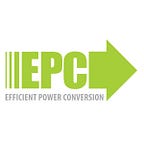New 100 V eGaN® Devices Increase Benchmark Performance Over the Aging Silicon Power MOSFET
Efficient Power Conversion (EPC) is increasing the performance distance between the aging silicon power MOSFET and eGaN transistors with 100 V ratings. The new fifth-generation “plus” devices have about 20% lower R DS(on) and increased DC ratings compared with the prior fifth-generation products. This performance boost comes from the addition of a thick metal layer and a conversion from solder balls to solder bars.
The first two products, EPC2204 and EPC2218, are shown in figure 2 and are compared against the prior generation eGaN FETs. For example, the EPC2204 is the same die size as the EPC2045, yet has 80% higher continuous current capability (I DC_CONT), 20% lower on-resistance (R DS(on)), and 70% lower junction-to-board thermal resistance (R ΘJB).
To illustrate the significant performance advantage over Si power MOSFETs, figure 3 compares both the fifth generation and fifth generation “plus” eGaN FETs against a benchmark silicon device, the BSZ070N08LS5 from Infineon. The EPC2204 has 25% lower R DS(on), yet is three times smaller in size. Gate charge (Q G) is less than half with the new technology, and like all eGaN FETs, there is no reverse recovery charge (Q RR) enabling lower distortion class D audio amplifiers as well as more efficient synchronous rectifiers and motor drives.
Additional confirmation of the advantages of the new-generation 100 V eGaN FETs is illustrated in the performance graphs in figure 4. A buck converter operating at 2 MHz converting from either 12 V or 24 V to 3.3 V is shown. The red lines are the efficiency and power loss from the benchmark Infineon 60 V MOSFETs compared with the blue lines for the EPC2204 and EPC2218 devices.
With devices as small as these new generation eGaN FETs, a common question is how well they can dissipate heat in operation. Thanks to the chip-scale packaging, thermal efficiency is much higher than the comparable silicon device in a package. As an example, in figure 5 is a 4 mm 2eGaN FET similar to the EPC2204 showing 4 °C/W thermal resistance with 6 W power in the device. We show a simulated image for clarity, but the actual capability of the device was experimentally confirmed.
With the clear superiority of these new 100 V eGaN FETs, one might expect them to be priced at a premium. However, EPC has priced these state-of-the-art 100 V transistors comparable with their aging ancestor, the silicon power MOSFET.
To assist the design engineer in getting products to market faster, EPC has a host of design tools, development kits, and reference designs that utilize these chip-scale products.
Figure 6 lists the parts, their corresponding development kits and available reference designs. All EPC products have PSPICE, TSPICE, LTSPICE, Spectre, Altium and thermal device models available here.
Figure 6: Table showing the available development kits and reference designs for EPC2204 and EPC2218 100 V eGaN FETs.
An example of a reference design using the EPC2218 is the ultra-thin EPC9153 buck converter in figure 7. This buck converter is designed to fit into very thin products such as monitors and notebook computers where the input voltage is between 40 and 60 V. Measuring only 6.5 mm in thickness, it is over 98% efficient (see figure 8) and has a temperature rise of only 35°C without added heatsinking or airflow.
The same design can be configured for 12V regulated output. The efficiency versus load power for 12 V output voltage is shown in figure 9. Full load efficiency reaches 97.4% at 56 V IN and 97.6% at 48 V IN at steady state.
EPC’s newest generation of 100 V eGaN FETs achieve higher performance in a smaller, more thermally efficient size, and at a comparable cost to the aging silicon MOSFET. Compared to the prior eGaN FET generations, these new products are lower in on-resistance, lower in thermal resistance, have a higher rated DC current capability, and are priced comparably with power MOSFETs with comparable ratings. The inevitable obsolescence of the aging power MOSFET is becoming more evident every day.
Originally published at https://epc-co.com on September 22, 2020.
